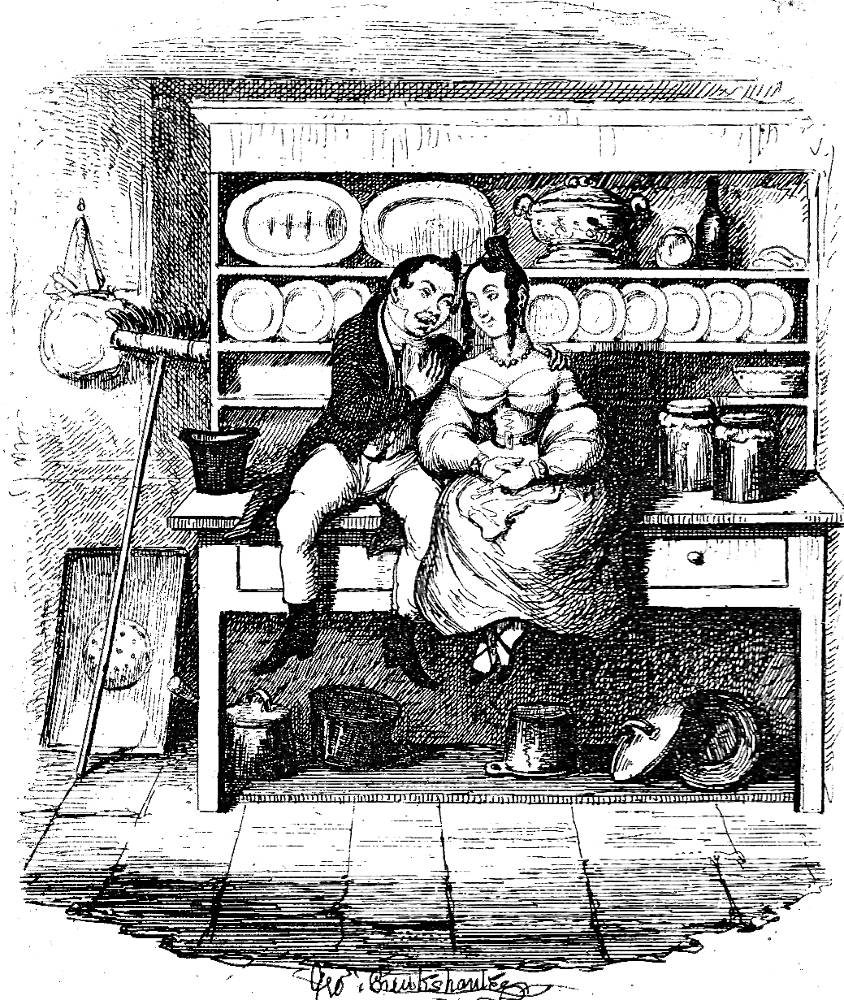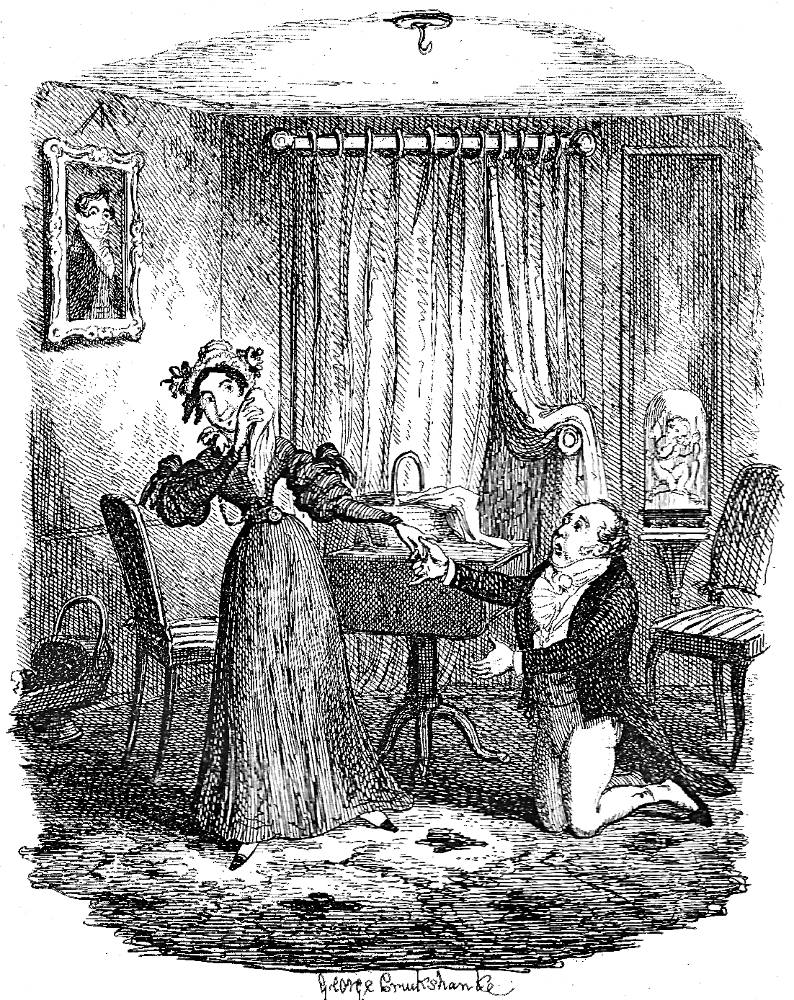
"Why," replied Mr. Watkins Tottle, evasively; for he trembled violently, and felt a sudden tingling throughout his whole frame; "Why — I should certainly — at least, I think I should like —" (wood-engraving). 1876. 4 ⅛ by 5⅜ inches (10.6 cm high by 13.7 cm wide), framed. — Fred Barnard's realistic response to the pathetically humorous, two-part short story. This, the first of two illustrations for this story that Barnard prepared for Household Edition, parallels the first of three copper-engravings that Dickens's chief illustrator at this point, George Cruikshank, produced for the Chapman and Hall one-volume edition of Sketches by Boz. In Watkins Tottle, the sole illustration for the first part which appears at the head of the story, Cruikshank represents a much younger version of Gabriel Parsons in the flashback that he narrates for the edification of his interlocutor, Watkins Tottle, in the bachelor's rooms in Cecil Street, Strand. The not-entirely-welcome visitor, after requesting a drink, attempts to enlist the old bachelor in a scheme to marry a rich spinster, knowing full well that Tottle, having received his periodical payment almost two weeks before, is (as usual) hard up and desperate.
Scanned image, colour correction, sizing, caption, and commentary by Philip V. Allingham. [You may use this image without prior permission for any scholarly or educational purpose, as long as you (1) credit the person who scanned the image, and (2) link your document to this URL in a web document or cite the Victorian Web in a print one.] Click on the image to enlarge it.
Passage Illustrated: Gabriel Parsons narrates a farcical flashback
"Tottle," said Mr. Gabriel Parsons, "you know my way — off-hand, open, say what I mean, mean what I say, hate reserve, and can't bear affectation. One, is a bad domino which only hides what good people have about 'em, without making the bad look better; and the other is much about the same thing as pinking a white cotton stocking to make it look like a silk one. Now listen to what I'm going to say."
Here, the little gentleman paused, and took a long pull at his brandy-and-water. Mr. Watkins Tottle took a sip of his, stirred the fire, and assumed an air of profound attention.
"It's of no use humming and ha'ing about the matter," resumed the short gentleman. — "You want to get married."
"Why," replied Mr. Watkins Tottle evasively; for he trembled violently, and felt a sudden tingling throughout his whole frame; "why — I should certainly — at least, I thinkI should like — "
"Won’t do," said the short gentleman. — "Plain and free — or there's an end of the matter. Do you want money?"
"You know I do."
"You admire the sex?"
"I do."
"And you’d like to be married?"
"Certainly."
"Then you shall be. There's an end of that." Thus saying, Mr. Gabriel Parsons took a pinch of snuff, and mixed another glass.
"Let me entreat you to be more explanatory," said Tottle. "Really, as the party principally interested, I cannot consent to be disposed of, in this way."
"I'll tell you," replied Mr. Gabriel Parsons, warming with the subject, and the brandy-and-water — "I know a lady — she's stopping with my wife now — who is just the thing for you. Well educated; talks French; plays the piano; knows a good deal about flowers, and shells, and all that sort of thing; and has five hundred a year, with an uncontrolled power of disposing of it, by her last will and testament." — Chapter 1 of "A Passage in the Life of Mr. Watkins Tottle," Chapter 10 in "Tales," running head: "A Modern Lucretia," p. 208.
Commentary
Comic account of an impoverished middle-aged bachelor's attempt, initiated and organized by his prosperous friend, Gabriel Parsons, to capture the affections of a prim, well-to-do spinster, Miss Lillerton. During the course of the story Tottle is arrested for theft [actually, debt] and taken to a sponging-house, from which he is rescued by Parsons. — The Dickens Index, p. 191.
To suggest Tottle's trembling throughout his whole frame at the thought of engaging in a courtship at his time of life, Barnard has him rubbing his leg, as if to stimulate circulation. While Tottle is dressed in the now-old-fashioned style of the Regency with breeches and hose, his slightly younger visitor, the supremely self-confident and reasonably affluent sugar-baker, Gabriel Parsons, is wearing contemporary fashion (tailcoat and trousers) as he basks in the glow of the fire and Tottle's brandy-and-water. The flat candle which Tottle recently lit in order to fetch the brandy is now smoking on the mantlepiece, guttering out — like Tottle's romantic and marital aspirations. Clearly Frost demonstrates a preference for illustrating a farcical situation over Barnard's preference for introducing the characters of the narrator and auditor.
Illustrations from the 1839 and Other Editions for "Watkins Tottle"




Left: Cruikshank's initial illustration for the story, realizing Gabriel Parsons' flashback to his wedding-day when, afraid of encountering his father-in-law, he makes love to his bride on the kitchen settle, Watkins Tottle in "Chapter the First." Left of centre: Cruikshank's third illustration, which misleadingly suggests that Tottle will be successful in his courtship of the affluent spinster, Mr. Watkins Tottle and Miss Lillerton. Right of centre: Eytinge's single illustration, featuring Tottle (right), Rev. Timson (left), and Parsons (centre), as they learn of Miss Lillerton's engagement to the Anglican minister, Mr. Watkins Tottle (1867). Right: Furniss's realisation of the agent of the lock-up house, The Sheriff-Officer's Mercury (1910) in the second chapter. [Click on the images to enlarge them.]
The First Illustration from The American Household Edition (1877)

Above: Arthur B. Frost's wood-engraving of the scene in which Gabriel Parsons hides in the kitchen chimney-piece, "And, as Fanny and the girl replaced the deal chimney-board." [Click on the image to enlarge it.]
The Second Illustration from The British Household Edition (1876)

Above: Fred Barnard's wood-engraving of the scene in the second half of the story, in which Solomon Jacobs' minion reveals that Tottle has been apprehended for debt, "I've brought this here note," replied the individual in the painted tops in a hoarse whisper; "I've brought this here note from a gen'l'm'n as come to our house this mornin'." [Click on the image to enlarge it.]
Bibliography
Ackroyd, Peter. Dickens: A Biography. London: Sinclair-Stevenson, 1990.
Bentley, Nicholas, Michael Slater, and Nina Burgis. The Dickens: Index. Oxford: Oxford U. P., 1990.
Davis, Paul. Charles Dickens A to Z. The Essential Reference to His Life and Work. New York: Checkmark and Facts On File, 1998.
Dickens, Charles. ""A Passage in the Life of Mr. Watkins Tottle," Chapter 10 in "Tales," Sketches by Boz. Illustrated by George Cruikshank. London: Chapman and Hall, 1839; rpt., 1890. Pp. 326-55.
Dickens, Charles. "A Passage in the Life of Mr. Watkins Tottle," Chapter 10 in "Tales," Christmas Books and Sketches by Boz, Illustrative of Every-day Life and Every-day People. Illustrated by Sol Eytinge, Jr. The Diamond Edition. Boston: James R. Osgood, 1875 [rpt. of 1867 Ticknor and Fields edition]. Pp. 465-85.
Dickens, Charles. "A Passage in the Life of Mr. Watkins Tottle," Chapter 10 in "Tales," Sketches by Boz. Illustrated by Fred Barnard. The Household Edition. London: Chapman and Hall, 1876. Pp. 115-117.
Dickens, Charles. Part IV, "Tales," Chapter X, "A Passage in the Life of Mr. Watkins Tottle." Sketches by Boz. Illustrated by A. B. Frost. The Household Edition. New York: Harper and Brothers, 1877. Pp. 253-268.
Dickens, Charles. "A Passage in the Life of Mr. Watkins Tottle," Chapter 10 in "Tales," Sketches by Boz. Illustrated by Harry Furniss. The Charles Dickens Library Edition. London: Educational Book Company, 1910. Vol. 1. Pp. 419-55.
Hawksley, Lucinda Dickens. Chapter 3, "Sketches by Boz." Dickens Bicentenary 1812-2012: Charles Dickens. San Rafael, California: Insight, 2011. Pp. 12-15.
Kitton, Frederic G. "George Cruikshank." Dickens and His Illustrators. London: Chapman & Hall,1899. Rpt. Honolulu: U. Press of the Pacific, 2004. Pp.1-28.
Schlicke, Paul. "Sketches by Boz.Oxford Reader's Companion to Dickens. Oxford: Oxford U. P., 1999. Pp. 530-535.
Slater, Michael. Charles Dickens: A Life Defined by Writing. New Haven and London: Yale U. P., 2009.
Last modified 26 April 2019